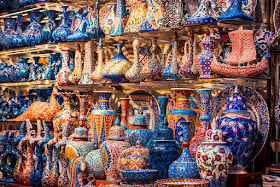Let's imagine we wake up in the Mesihpaşa neighborhood, where there a lot of hotels and where many visitors stay.
The mosque was built in 1550–57 for Sultan Süleyman I, “the Magnificent”. It was designed by one of the greatest artists you may never have heard of, called in modern Turkish Mimar Sinan, that is Sinan the Architect. Sinan (1490-1588) was either Armenian or Greek by birth; the son of a stone mason, he trained as a military architect and did not embark on his career of designing mosques and palaces until he was past 50. Fortunately for us he lived a very long life so was still able to design more than 100 mosques and 70 schools. It also helped that his life coincided with the peak of Ottoman wealth and grandeur.
There are multiple levels to appreciating the architecture of Istanbul. There is the first impression of the grand structure, its domes looming against the sky or above your head. Wow. But they you must turn your attention to the details, for these builders could put as much wonder in a single courtyard as in a whole palace, and as much beauty in one tile as a courtyard.
We could linger here all day, admiring the fountains and tombs, but there is so much else to see.
As all tourists must we make our way to the Grand Bazaar, actually a network of alleyways, some as well-roofed as a modern mall, others rougher and not completely covered.
From here we're going to hop the street car that runs down Yeniçeriler, the Street of the Janissaries, until we reach Mehmet Akif Ersoy Park.
From there's it's a very short walk to our next stop, the ancient Hippodrome of Constantinople, now a public square still marked by two ancient obelisks.
This seems to have been built around 203 AD, when Emperor Septimus Severus expanded the City of Byzantium, built it new walls, and endowed several buildings. It was enlarged by Constantine. It was, archaeologists think, 1500 feet (450 m) long, and its stands could hold 100,000 spectators.
Among the pieces you can still see is the base of one of the obelisks, showing Emperor Theodosius offering the laurel wreath to a victor. We saw the bronze horses that once adorned the Hippodrome last week during our tour of Venice.
Right across the street from the Hippodrome is the great Blue Mosque or Sultan Ahmed Mosque, built by Ahmed I between 1609 and 1616. The mosque is so big that it is actually hard to see it very well from the street, so most of the famous pictures are taken from the air or the water, but I'm trying to focus mostly on what we would see as we explore the city on foot.
The interior is delightful, but this is still a functioning mosque, so mind your manners.
From there we walk about half a mile (0.8 km) across a series of parks and squares, passing the Sultan Ahmad fountain
To the Hagia Sophia, one of the most extraordinary remnants of the classical world, built in 532 to 537 AD. Its construction was ordered by Justinian I to replace an earlier church that had been burned in the Nika Riots that nearly ended his rule. It was designed by the engineer Isidore of Miletus and the mathematician Anthemius of Tralles. It was the cathedral of the city, and then its principal mosque, before becoming a museum after the fall of the Ottoman Empire and the founding of the modern Turkish state.
We pass through the mighty entrance
Into the famous interior,
With its extraordinary mosaics.
From there let us walk through more parks to the Istanbul Archaeological Museum.
Here we can wallow in remnants of the Greek and Byzantine past, or explore older marvels like relics of Babylon and Sumer. Among the artifacts here are the famous sarcophagi of Sidon I wrote about in February.
Adjacent to the archaeological museum is the wall of Istanbul's great palace, the Topkapi. This hill overlooks the spot where the inlet called the Golden Horn meets the Bosphorus Strait. This was the original site of Byzantium's acropolis, and then the palace of the Caesars. The older palace was wrecked during the great siege of 1453, and Sultan Mehmet the Conqueror decided to level everything and start over. The palace was open, and its basic plan in place, by 1465.
The palace grew over time into a small city of its own, with offices and pavilions
courtyards
kitchens (built in the 1460s)
and audience chambers.
Into main reception hall where one might behold the Sultan sitting on the Imperial Sofa.
Much of this has been made into a series of museums; the old treasury holds the famous Ottoman collection of arms and armor.
And we end our day on one of the palace's many terraces with their spectacular views of the sea.

































No comments:
Post a Comment